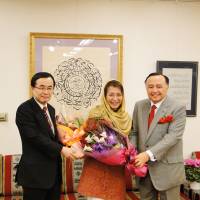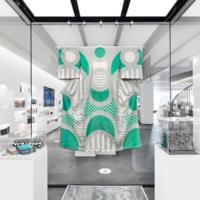An exhibition of Arabic calligraphy was held from Dec. 10 to 23 at the Royal Embassy of Saudi Arabia in Tokyo.
Arabic calligraphy is the artistic handwriting practice used in lands sharing a common Islamic cultural heritage. Calligraphy is especially revered among Islamic arts since it was the primary means for the preservation of the Quran. Using "qalam," a type of pen made from a dried reed, transcribers have created many different styles, some of which have been passed down over thousand years up to the present time. This art of writing, with its abstract-artlike flowing curves, has developed as a major form of artistic expression to take the place of paintings and sculpture in Islamic cultures, where idolatry is forbidden.
The exhibition presented the works of Japanese specialist Nobuko Sagawa, who studied Arabic calligraphy in Damascus from 1988 to 1990 under calligrapher Muhanmad Al-Qadi.
A reception was held Dec. 20 at the embassy, attended by Kazuyuki Hamada, then parliamentary vice minister for foreign affairs, who offered his congratulations and emphasized the importance of learning about Islamic culture through Arabic calligraphy, saying, "The art form has much in common with Japanese calligraphy."
















With your current subscription plan you can comment on stories. However, before writing your first comment, please create a display name in the Profile section of your subscriber account page.